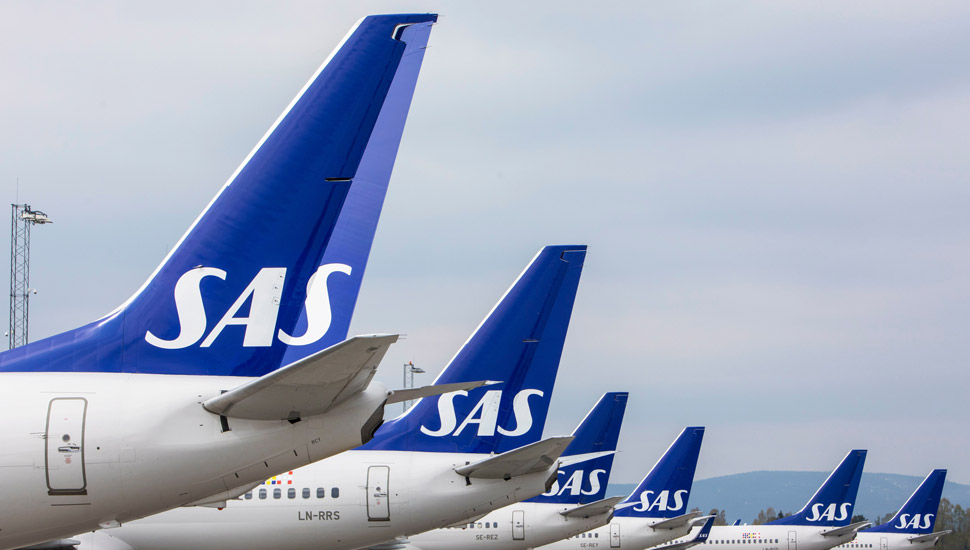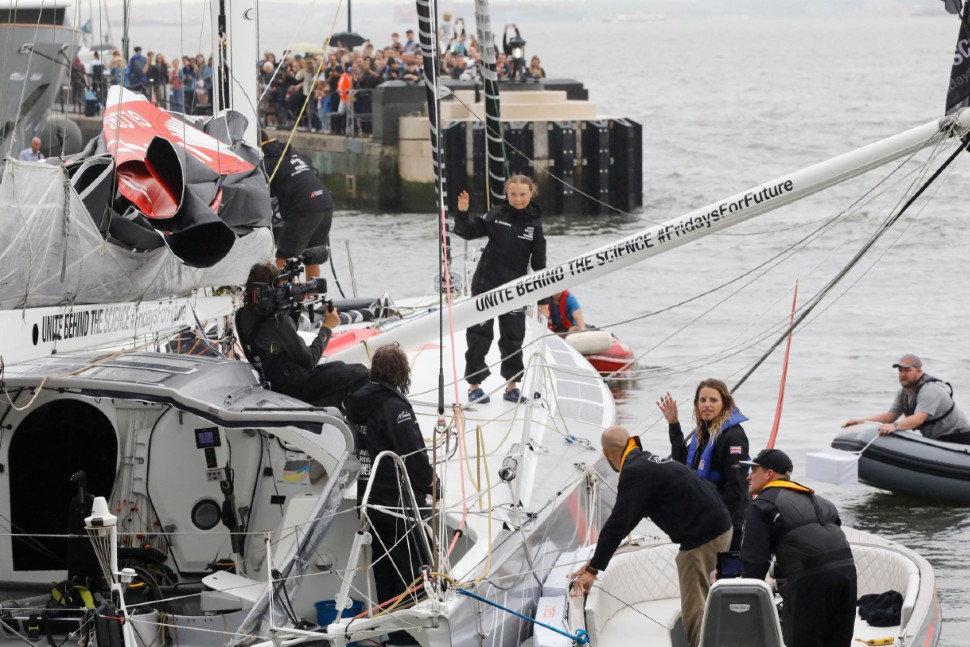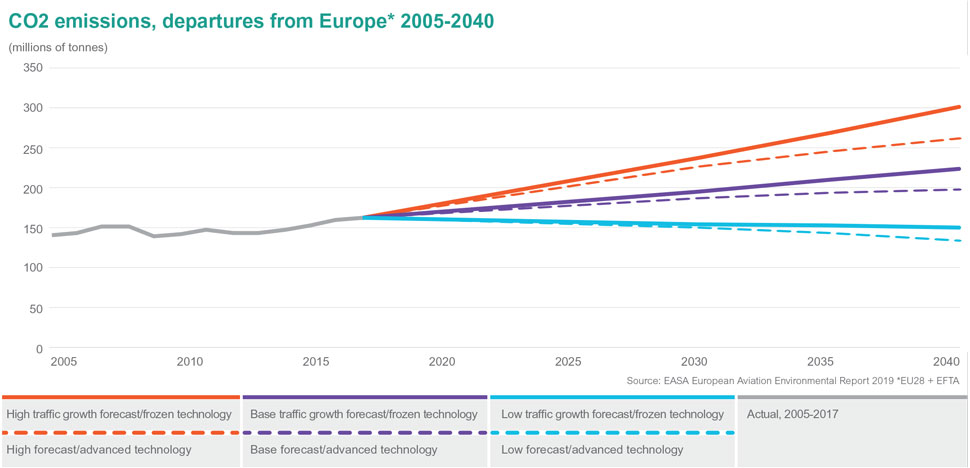Swedish might not be one of the world's most widely spoken languages – but most people are now familiar with the term "flygskam". This "flight shame" campaign to make people think twice about travelling by air because of concerns about the aviation industry's impact on climate change is gathering pace – and it is already having an impact on passenger numbers in its country of origin.
As more people sign up to movements on social media carrying hashtags such as #StayGrounded and #FlyingLess, airlines face more public pressure than ever to show that they are serious about cutting carbon dioxide (CO2) emissions.

Shutterstock
Growing social awareness and public debate has given politicians in the Netherlands and Sweden the ammunition to pursue attempts to introduce an EU-wide environmental tax on aviation, and it has pushed the European Union Aviation Safety Agency (EASA) to consider introducing an aircraft emissions grading system that will enable people to make more informed choices and opt for the most fuel-efficient carriers when booking a flight.
Airline industry representatives say they have yet to see a meaningful reduction in passenger numbers as a result of flygskam. Behind the scenes, however, they are stepping up efforts to publicly communicate the efficiency measures they are putting in place, in the hope that they can wrest control of the debate from the hands of an increasingly vocal anti-flying lobby.
But in the home of flygskam and teenage climate change activist Greta Thunberg, the effects are already starting to bite. Swedish airports operator Swedavia reported in July that passenger numbers across its 10 airports for the first half of 2019 had declined by 4% in the first half of 2019 versus the same period last year. The biggest drop was seen in domestic passenger numbers, which fell 8%, but international passenger numbers also dropped by 2.8%.

Greta Thunberg arrives in New York, pointedly not by air
Mark Lennihan/AP/Shutterstock
NEGATIVE TREND
While several other factors were also to blame, it is clear that flight shame played a role, particularly on the domestic air travel front. "For several years, there has been incredible growth at Swedavia's airports. However, the growth of traffic has been negatively affected by the climate debate, the introduction of air tax and the economic downturn," says Swedavia director aviation business Elizabeth Axtelius. "It is not possible to determine to what extent environmental reasons [are to blame], but the climate debate affects domestic air traffic where the distances are relatively short and other means of transportation are possible."
Axtelius adds that this "negative trend", which was initially "a slowing growth" but then became "an actual decrease", began "around the middle of last year".
Swedish rail company SJ is benefiting from this change in consumer attitudes and behaviour. It reports that twice as many Swedish people chose to travel by train instead of by air in summer 2019 compared with the previous year. "Swedes' travel patterns have changed dramatically as a result of the climate debate," says the rail operator.
Meanwhile, Swedavia says it is investing heavily to "transform aviation in the face of climate change". The airports operator has produced a roadmap aimed at making domestic air transport "fossil free by as early as 2030" and ensuring that "all flights taking off from Swedish airports can be fossil free by 2045", says Axtelius.
Last year, Swedavia set a target for 5% of jet fuel used at Swedish airports to be renewable by 2025, which Axtelius says "corresponds to the pace needed to achieve fossil-free domestic air travel by 2030". She acknowledges that these targets can only be achieved through close collaboration, both within and outside the aviation industry, but says building a sustainable future is essential.
"Sweden is a remote and relatively small country. For our export industry, to do business, to enable people to meet and visit families and friends, and for transportation of high-value cargo, air traffic is crucial. It is not realistic that we stop flying, but the transport modes of the future must be sustainable."
In a bid to help the travelling public make more sustainable choices when they do choose to fly, EASA is designing a grading system for aircraft environmental performance, including carbon emissions. The idea is to provide a single source of easily accessible, easy-to-understand data showing how airlines' fleets rank on fuel efficiency and noise.
Kai Bauer, principal adviser for environment and sustainability to EASA's strategy and safety management director, says one of the "triggers" for examining an aircraft emissions labelling system was the "changing world" of public opinion on climate change. "In other industries, labelling systems have been used to communicate environmental performance to the general public. In this changing world, a labelling system for the aviation industry can play a role," says Bauer. "A starting point for our exploration was to address concerns expressed by European citizens."

Passenger numbers are down this year at Swedish airports including Stockholm Arlanda
Daniel Asplund/Creative Commons
RESEARCH EFFORT
EASA surveyed 6,000 respondents from 15 EU member states and found that 80% were "open to receiving environmental information in the form of a label", and the majority wanted the information to be available "during the booking process or on the boarding pass".
The agency is in the "proof of concept" stage for the system and aims to set out a more detailed plan by the end of the year, with the intention of launching it in 2020. One option under consideration when it comes to presentation is a colour-coding system so "people can easily understand where there is good performance", says Bauer. "The aim is to increase awareness and transparency, and ultimately help passengers make more informed choices."
While the details are still being hammered out, EASA aims to use data generated by the certification process for the ICAO noise and emissions standards, including the new CO2 standard from 2020, as the basis for its proposed grading system. The labelling system is "intended as a voluntary scheme", but Bauer says that despite some concerns over the type of data that ends up being used, some airlines expressed broad interest in the idea: "We've had initial discussions with some airlines and we've found broad agreement that there's a need to communicate on environmental performance.
"Airlines also had legitimate concerns to make sure the data is robust and doesn't compare things that aren't comparable."
Growing environmental concerns have also emboldened some EU member state governments to call for the introduction of a pan-European aviation tax. Earlier this year, the Dutch government, supported by Sweden, stepped up efforts to achieve a more co-ordinated approach to taxing airline tickets and/or kerosene, which is currently exempt from excise duties.
The Netherlands has threatened to reintroduce its own national aviation tax if an EU-wide agreement cannot be reached by 2021. As it stands, six EU member states – Austria, France, Germany, Italy, Sweden and the UK – have implemented domestic aviation environmental taxes.
In a recent research note, Bernstein analyst Daniel Roeska cautioned that there will likely be "more pressure on air travel from taxes or offsetting schemes" going forward. "If airlines do not watch out, they will be taxed multiple times. Air travel is an easy target for more taxation," writes Roeska. "The best course of action airlines can take is to be proactive in their efforts to reduce carbon emissions and offset the emissions they cannot."
According to the Air Transport Action Group (ATAG) – an industry association that "works to promote aviation's sustainable growth for the benefit of our global society” and whose members include a familiar list of aircraft and engine makers, and airport and airline industry associations – taxes are not the answer to the industry's environmental conundrum. Instead, ATAG urges governments to focus instead on the development of sustainable fuels and more efficient air traffic management (ATM) procedures.

"Governments have a massive role to play and we are concerned to see that they tend to focus on their old and easy solution – taxes. These do nothing to reduce CO2 emissions and are a distraction allowing politicians to proclaim that they did something," says ATAG communications chief Haldane Dodd. "Putting in place proper policy frameworks for SAF [sustainable aviation fuel] deployment, or working with the industry on ATM improvements takes longer and is a harder process, but it actually will cut CO2 in an effective way."
ATAG believes that growing public pressure "helps inspire further action by players across the sector", says Dodd. He points to progress made so far on the environmental goals set by IATA a decade ago, but says efforts must be stepped up to communicate this message more clearly to the public.
"Ultimately, passengers do not know how much the industry has been doing to reduce fuel use. Emissions today per passenger kilometre have improved by over 17% compared to when our industry set the sectoral goals in 2009. If you fly a full, latest-generation aircraft your per-km emissions will be about the same as a small car."
Dodd adds that he has "heard anecdotes of people in Sweden deciding that they should not fly to Spain on holiday because of the 'shame' aspect, and hopping in their cars instead, which obviously brings with it a higher CO2 footprint".
He says this demonstrates the need for airlines to communicate with their passengers about the efficiency measures they are taking: "Hopefully this pressure will give the public-facing industry a bit more of a push to step up both communications activity and efficiency measures. We are going to be encouraging them to do that, as well as increasing our own activity and are putting together some ideas on that right now."
But while emissions may have fallen on a per passenger kilometre basis, it is the significant global growth in the number of passengers flying that is prompting environmental concerns. Bauer points to EASA's latest European Aviation Environment Report which, he says, demonstrates that while today's aircraft burn less fuel than previous models, the "absolute impact" of aviation is "going a different way". The report shows that full-flight CO2 emissions in Europe increased by 16% between 2005 and 2017, on the back of a 60% increase in the number of commercial passenger kilometres flown.
EASA recognises in its report that the continued growth of the aviation industry "has produced economic benefits and connectivity within Europe, and is stimulating investment in novel technology". However, it adds that "the contribution of aviation activities to climate change, noise and air quality impacts is increasing, thereby affecting the health and quality of life of European citizens".
ON MESSAGE
Some airlines are already starting to communicate directly with their passengers about climate change. For instance, KLM in July launched a public campaign called "Fly Responsibly", in which it not only described the measures it has taken to reduce emissions but also encouraged people to take their own steps to travel more responsibly.
The airline even advised passengers to "explore other travel options", pointing out on its website that "in some cases, railway or other modes of transportation can be more sustainable than flying, especially for short distances such as within Europe".
Airline bosses are beginning to publicly vocalise their jitteriness about growing environmental pressure. Lufthansa Group chief executive Carsten Spohr said, as he collected the Executive Leadership Award at the FlightGlobal Airline Strategy Awards on 14 July, that the environment "wants to be taken as seriously as the other three stakeholders" – customers, employees and shareholders.

Carsten Spohr: environment is now an aviation "stakeholder"
BillyPix
"I think recently, just in the last weeks and months in particular, a fourth stakeholder has appeared, and that's the environment," said Spohr, adding that this new stakeholder's voice "will be heard just as loud as the other voices have been heard" going forward.
This sentiment was echoed by Henrik Hololei, the European Commission's director general for mobility and transport, during a speech at the International Aviation Club in Washington DC on 23 July. Hololei described the aviation industry's response to its growing CO2 footprint as "very timid and complacent" and warned of mounting societal and regulatory pressure on the sector.
"In order to maintain the 'licence to grow' – one pessimist even referred to the 'licence to exist' – emissions have to come down. In Europe, we observe that people's mind-set about that is changing very fast and, without the slightest doubt, public demand and societal expectations for cleaner and much more sustainable air transport will grow rapidly in the coming years," said Hololei.
"We already see these significant and rather disruptive signs that we did not witness just a year or two ago. If the industry is not delivering credible responses to show that it can continue to grow while reducing emissions, this pressure will only mount and, sooner than later, regulatory intervention follows."
Hololei acknowledges that "Europe’s sentiment and societal expectations in this are today ahead of other regions", but warns that "it is just a matter of time before this wave spreads to the rest of the world".
Source: Flight International






















